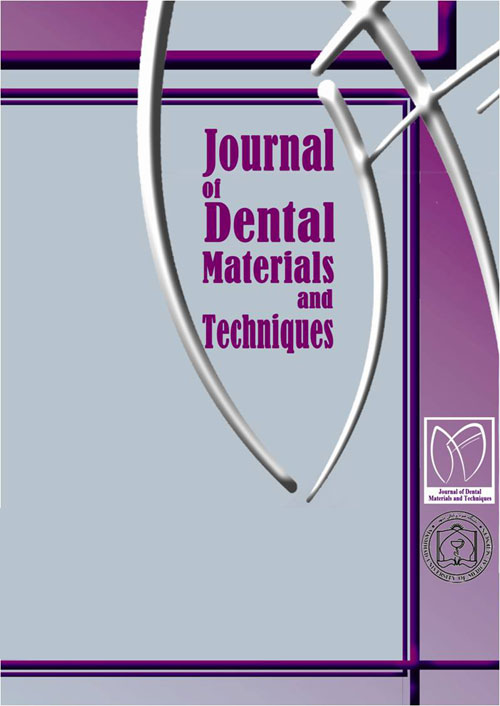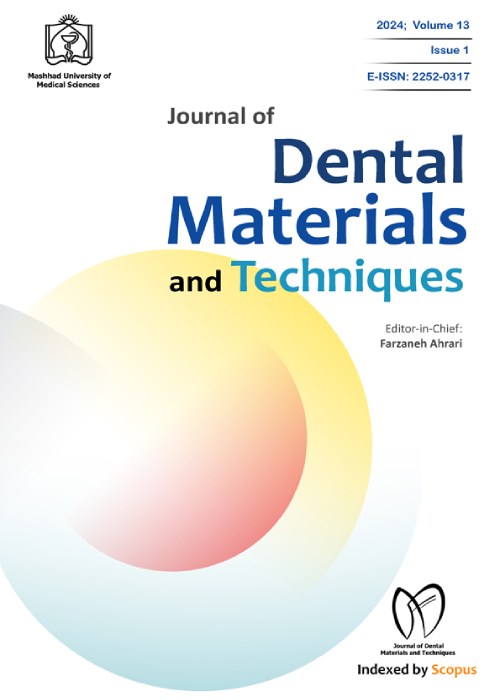فهرست مطالب

Journal of Dental Materials and Techniques
Volume:4 Issue: 4, Autumn 2015
- تاریخ انتشار: 1394/07/02
- تعداد عناوین: 8
-
-
Pages 137-144Making a conservative bridge using a natural tooth pontic with mobile teeth is complicated, time-consuming and sometimes impossible with the current techniques and materials. The aim of this paper is` to describe a new method using Special Rigid Tray Technique (SRTT) to deal with such difficult clinical cases.Keywords: Natural Tooth Pontic, Splint, Rigid Special Tray
-
Pages 145-152IntroductionThe purpose of this preliminary study was to evaluate the periodontal condition of intruded molars in various phases of treatments.Methods30 patients with at least one overerupted upper first molar were selected. Upper molar bands with brackets were cemented. Two miniscrews were placed in the mesiopalatal and mesiobuccal aspect of the aforementioned teeth. A titanium molybdenum alloy (TMA) spring was attached to the head of miniscrew in one end and ligated to the bracket in the other end to reach the predetermined force. Plaque index (PI), probing pocket depth (PPD), keratinized gingiva (KG), The distance between miniscrew (M.S) and gingival level (GL), and bleeding on probing (BOP) were recorded before loading and 1, 2, 3, 4 and 5 months post-loading.ResultsAll patients completed the study and no complications were reported. Statistically significant intrusion (2.1 ± 0.9 mm) was obtained during active treatment. Inserting miniscrews generally was presented with greater sulcus bleeding, plaque accumulation and plaque formation at follow-up visits. There was a statistically significant increase in PI, PPD and BOP indices. Furthermore, the results showed decrease in KG level and M.S to GL level.ConclusionMiniscrews can provide a clinical benefit as an absolute anchorage device. However, keeping a good oral hygiene is essential to achieve ideal results, because the presence of miniscrews, as a foreign object in mouth, and intrusion force might be harmful for periodontal tissuesKeywords: Intrusion, mini implant, mini, screw, over, erupted molar, soft tissue health
-
Pages 153-160BackgroundThe clinical success of sandwich technique depends on the strength of resin-modified glass ionomer cement (RMGIC) bonding to both dentin and resin composite. Therefore, the shear bond strength (SBS) of resin composite bonded to RMGIC utilizing different resin adhesives versus a GIC-based adhesive was compared.Materials And MethodsIn this in vitro study, 84 holes (5×2 mm) were prepared in acrylic blocks, randomly divided into seven groups (n=12) and filled with RMGIC (Light-Cured Universal Restorative, GC). In the Group I; no adhesive was applied on the RMGIC. In the Group II, non-etched and Group III was etched with phosphoric acid. In groups II and III, after rinsing, etch-and-rinse adhesive (OptiBond Solo Plus); in the Group IV; a two-step self-etch adhesive (OptiBond XTR) and in Group V; a one-step self-etch (OptiBond All-in-One) were applied on the cement surfaces. Group VI; a GIC-based adhesive (Fuji Bond LC) was painted over the cement surface and cured. Group VII; the GIC-based adhesive was brushed over RMGIC followed by the placement of resin composite and co-cured. Afterward; resin composite (Point 4) cylinders were placed on the treated cement surfaces. The specimens were placed in 100% humidity at 37 ± 1°C and thermo cycled. The shear bond test was performed at a cross-head speed of 1 mm/min and calculated in MPa; the specimens were examined to determine mode of failure. The results were analyzed using one-way ANOVA and Tukey test.ResultsThe maximum (24.62±3.70 MPa) and minimum (18.15±3.38 MPa) SBS mean values were recorded for OptiBond XTR adhesive and the control group, respectively. The pairwise comparisons showed no significant differences between the groups that bonded with different adhesives. The adhesive failure was the most common failure mode observed.ConclusionThis study suggests that GIC-based adhesive could be applied over RMGIC as co-cure technique for sandwich restorations in lieu of employing the resin adhesivesKeywords: glass, ionomer based adhesive, dental adhesives, resin, modified glass, ionomer cement, resin composite, shear bond strength
-
Pages 161-166ObjectivesThe aims of this study were to test whether lightening of the overexposed radiographs improve determination of endodontic files length and whether lightened radiographs are comparable with ideally exposed radiographs.Material And MethodsFour dried human skull coated with soft tissue-equivalent wax used for exposing radiographs of the upper molars. First, the endodontic file was placed in full length of the root and four series of radiographs obtained. The time to expose the first series was unchanged (standard group) but increased for the other three series. Two series of overexposed radiographs set as test groups (one lightened with copper sulfate reducer and the other lightened with sodium hypochlorite) and one series set as control group. Then the endodontic file placed 2mm short in the root and four series of radiographs obtained like the former. A viewer evaluated radiographs. ROC curves were obtained and areas under the curves were calculated. Sensitivity, specificity and Cohen’s kappa was calculated.ResultsThe average area under ROC curves was 1, 0.995,1 and 0.643 for the standard, Copper sulfate, sodium hypochlorite and the control group, respectively. Sodium hypochlorite show a better performance in terms of sensitivity and specificity compared to Copper sulfate. Differences between the test radiographs and standard and control radiographs were significant (p<0.05), but not between Copper sulfate lightened radiographs and control radiographs (p=0.784).ConclusionLightening with NaOCl is a cheaper and less cumbersome method which need only one minute to correct the radiograph.Keywords: Dental radiography, Copper sulfate, Reducer, Sodium hypochlorite
-
Pages 167-172BackgroundEarly Childhood Caries (ECC) in the earliest stage is preventable. The studies indicate oral bacteria play an important role in pathogenesis of dental caries. According to high prevalence of ECC, alternative therapies should be explored in order to reduce the occurrence of it.AimThis study aims to assess the effectiveness of a product containing Povidone Iodine 10% and Sodium Fluoride 0.2% as a supplementary intervention for preventing ECC.Materials And MethodsThirty-seven children aged 4 to 6 year-old were recruited. Maxillary incisors on each side of the mouth were selected either as a test or control group. Early caries detection examinations were conducted using International Caries Detection and Assessment System (ICDAS) clinically and photographically. In a double-blind, placebo-controlled clinical study, a product containing a mixture of Povidone Iodine 10% and Sodium Fluoride 0.2% was applied to the designated incisors of the test group participants. This application was performed every week for a 3-month. The control group participants received a placebo mixture during the same time interval. The caries detection examinations were conducted again after 6 months and the results were compared. The data was analyzed with SPSS V.18, using McNemar test.ResultsThe incidence of carious lesions increased for the control group while it decreased in the test group (P<0.05)ConclusionA product containing PI and F can be effective in preventing ECC.Keywords: Early childhood caries, Povidone, iodine, Prevention, Sodium fluoride
-
Pages 173-175Aimthe aim of this study was to compare cusp deflection, infraction and fracture in teeth filled with three temporary filling materials.Materials and MethodForty five extracted human premolar teeth were chosen. After root canal therapy and mesio-occluso-distal cavity preparation, samples were randomly divided into three groups, each contained 15 teeth and filled with three temporary filling materials: Cavisol (Golchai-Iran), Coltosol F (Coltene,Swiss) and Coltene (Ariadent,Iran). Teeth were kept in normal saline at room temperature and every day the intercuspal distance was measured under stereomicroscope for 20 days. Infractions as well as fractures were also noted. Data were analyzed in SPSS 17 using Repeated measurement ANOVA test to evaluate the intercuspal distance and expansion of each sample every day.ResultsIntercuspal distance increased in all three groups but was significantly more in Coltosol F group. On the days 10 and 16 two teeth filled with Coltosol F had cusp fracture.ConclusionTemporary filling materials have hygroscopic expansion and cause cusp deflection which may lead to cusp fracture, so it is recommended to use them in short period of time.Keywords: temporary filling material, tooth fracture, infraction, cusp deflection
-
Pages 176-182ObjectiveThis study aimed to assess the possible variations in root canal anatomy and topography of the apices of first and second maxillary molars.Materials And MethodsA total of 67 first and second maxillary permanent molars were collected. Access cavity was prepared and 2% methylene blue was injected. The teeth were demineralized by 5% nitric acid and cleared with methyl salicylate. Specimens were evaluated under stereomicroscopy and analyzed using the sample t-test.ResultsBased on Vertucci’s classification, the mesiobuccal root of maxillary first molars was type I in 87.5% and type IV in 12.5% of the cases. The mesiobuccal root of second maxillary molars was type I in 60%, type II in 8.6%, type IV in 25.7% and type V in 5.7% of cases. In maxillary first and second molars, the distobuccal and palatal roots were type I in 100% of the cases. The distance of the apical constriction from the apical foramen was 0.21±0.09 mm, the distance from the apical constriction tothe anatomic apex was 0.44±0.19 mm and the distance of the apical foramen from the anatomic apex was 0.15±0.15 mm. The mean percentage of delta prevalence was 3.2% in both teeth.ConclusionThe mean distance of the apical foramen and apical constriction from the anatomic apex was less than 0.6 and 1.2 mm, respectively. In maxillary first and second molars, the mean distance of the apical constriction from the apical foramen and anatomic apex was 0.21 and 0.44, respectively and the mean distance of the apical foramen from the anatomic apex was 0.15 mmKeywords: Apical constriction, Clearing, Apical foramen, Maxillary first molar, Maxillary second molar
-
Pages 183-186Squamous cell carcinoma (SCC) is the most common malignant tumors of oral cavity. The ratio of men to women is about 2: 1. Generally, it is admitted that 60% of carcinoma of the mandibular gingival are located in the posterior of premolars. Gingiva is one of the less common sites of oral squamous cell carcinoma (OSCC). Due to the variable clinical and behavioral presentations, it can easily be misdiagnosed as benign neoplasms or other inflammatory reactions. We encountered a 76-year-old woman with an unusual OSCC on the anterior mandibular ridge, imitating inflammatory hyperplastic (IH) lesion in May 2013. She complained that her denture was not seated suitably because of a mandibular lesion. After biopsy of the lesion, the surgeon noticed that real bone resorption was not visible in the x-ray image. Then histopathological evaluation detected the OSCC. Patient was referred to the CT-Scan and MRI. Three months later, the lesion recurred, enlarged and extended rapidly and she was emphasized the importance of a secondary surgery in a timely fashion.. She did not accept and then underwent radiotherapy and chemotherapy. In November 2013, the patient passed away because of the progress of OSCC. This case reminded us to keep the possibility of oral SCC in mind while examining every intra-oral lesion.Keywords: oral, SCC, hyperplastic lesion


